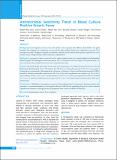Please use this identifier to cite or link to this item:
https://hdl.handle.net/20.500.14356/1590| Title: | Antimicrobial Sensitivity Trend in Blood Culture Positive Enteric Fever |
| Authors: | Joshi, Rajesh Dhoj Khadka, Sachin Joshi, Deepak Man Shrestha, Basudha Dangal, Ganesh Acharya, Kiran Prasad Shrestha, Sanjit Dongol, Yashad |
| Citation: | JoshiR. D., KhadkaS., JoshiD. M., ShresthaB., DangalG., AcharyaK. P., ShresthaS., & DongolY. (2018). Antimicrobial Sensitivity Trend in Blood Culture Positive Enteric Fever. Journal of Nepal Health Research Council, 16(2), 228-232. https://doi.org/10.33314/jnhrc.v16i2.1377 |
| Issue Date: | 2018 |
| Publisher: | Nepal Health Research Council |
| Article Type: | Original Article |
| Keywords: | Cephalosporin Enteric fever Sensitivity |
| Series/Report no.: | Apr-June, 2018;1377 |
| Abstract: | Abstract Background: For diagnosis of enteric fever, the culture of the organism from different body fluids is the gold standard. After diagnosis, it is important to treat with the right antibiotic before any complications can occur. The retrospective study is designed to explore the antibiotic sensitivity trend in blood culture positive typhoid fever cases and the extent of drug resistance before treatment is administered. Methods: A retrospective study was carried out for culture isolated enteric fever patients admitted in Kathmandu Model Hospital. The discharged records from January 2012 to December 2016 were analyzed. The patients above 15 years and with culture isolated enteric fever were included in the study. Results: One hundred fifty-nine strains of Salmonella typhi and paratyphi were isolated from Jan 2012 to Dec 2016 at Kathmandu Model Hospital. Out of 159 isolated, 125 (78.6%) were Salmonella typhi and 34 (21.4%) were paratyphi. Among them co-trimoxazole, chloramphenicol, ceftriaxone, cefotaxime, cefixime, and ofloxacin demonstrated 100% sensitivity. Similarly, amoxicillin sensitivity was 98.1% (n=156) while ciprofloxacin was sensitive in 6.3% (n=10), intermediately sensitive in 49.1% (n=78) and resistance in 44.7% (n=71).The newer quinolone levofloxacin showed 78.5% (n=11) sensitivity. Azithromycin was sensitive in 99.2% (n=132) of total isolated Salmonella species both typhi and paratyphi. Conclusions: A high degree of sensitivity was noted to chloramphenicol and co-trimoxazole, showing sensitivity has returned to conventional antibiotics. The drug-like ofloxacin is still the best responding drug in our contest whereas ciprofloxacin resistance is still high, but five years patterns show a trend of rollback of sensitivity. Keywords: Cephalosporin; enteric fever; sensitivity. |
| Description: | Original Article |
| URI: | http://103.69.126.140:8080/handle/20.500.14356/1590 |
| ISSN: | Print ISSN: 1727-5482; Online ISSN: 1999-6217 |
| Appears in Collections: | Vol. 16 No. 2 Issue 39 Apr-Jun 2018 |
Files in This Item:
| File | Description | Size | Format | |
|---|---|---|---|---|
| 1377-Manuscript-5337-1-10-20180703.pdf | Fulltext Download | 242.97 kB | Adobe PDF |  View/Open |
Items in DSpace are protected by copyright, with all rights reserved, unless otherwise indicated.
